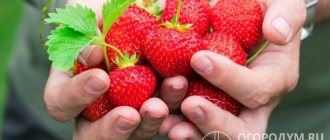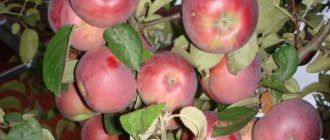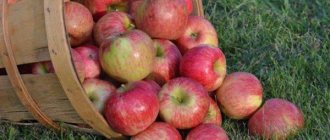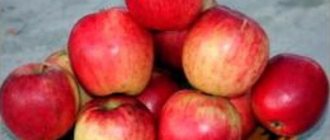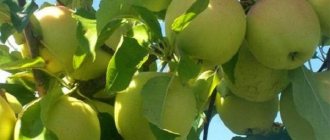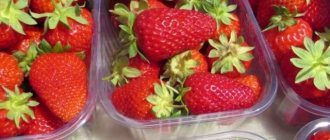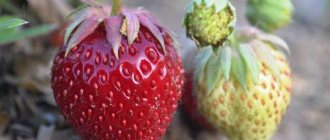Owners of garden plots do not always have the opportunity to pay much attention to their plantings. In such cases, varieties that are unpretentious in care and have strong immunity to diseases and pests come to the rescue. Strawberry Lambada, bred by Dutch specialists forty years ago, meets these criteria and is ready to compete in popularity with many modern varieties.
Strawberry Lambada was bred in 1982 by crossing varieties: Silvetta, Holiday, Karina, Primella
Description of the variety
Bushes
Lambada bushes look attractive: tall, slightly spreading, with large dark emerald leaves. Tall powerful flower stalks tend to rise above the foliage. Ripe fruits are easy to pick and will always be clean. A large number of tendrils allows you to quickly propagate the variety even from just a few bushes. During the flowering period, Lambada looks especially attractive: the flowers are large, snow-white, with a bright yellow core.
Berries
Lambada fruits are of a regular round-conical shape, homogeneous. The weight of the berry is larger than average, about 40 g. When ripe, it has a rich red color. The pulp is without voids inside, medium density, light red, pleasant taste and strawberry aroma. There is very little sourness, but there is much more sweetness than in many other varieties.
The peculiarity of Lambada strawberries is the raised sepals
Productivity
The Lambada variety is intended for cultivation in open ground. The berries ripen very early. The first collection is possible in the second half of May. In about 2 weeks, the bush will produce its entire harvest, which is approximately 400-600 g of berries. This level will remain for 2-3 years, starting from the second year. Then the bushes will age and the yield will decrease; the plantation will need to be renewed.
The berries are delicious fresh, in jam and compotes. The variety tolerates freezing well, without deteriorating its taste characteristics, but it is necessary to process the harvest as soon as possible, since the berries are not stored for a long time and quickly lose their merits.
Lambada strawberries are the best choice for those who want to get a quick harvest
When spring comes into its own, gardeners and gardeners can’t wait to pamper themselves and their loved ones with natural products from their own plot.
And, if several decades ago one could only dream of the aroma of fresh strawberries, which are officially called garden strawberries, at the beginning of May, now, thanks to the efforts of breeders, early varieties of these berries have appeared.
Very common among them are “Zarya”, “Camarosa”, “Stranger” and, of course, “Lambada”. Moreover, the latter is becoming more and more popular every year due to its bright aroma and unsurpassed taste.
Main properties of the variety
“Lambada”, bred in 1982 in the Netherlands, successfully grows both in greenhouses and in open ground, without requiring special care. The bushes usually grow tall, with few leaves. Strawberries of this variety quickly reproduce with tendrils and are characterized by the following basic properties:
- average yield,
- high frost resistance,
- abundant flowering.
It is worth noting that already in the first half of May it can please diligent gardeners with large, bright red, conical berries with a strong strawberry aroma.
The pulp of “Lambada” is light red in color, medium in density, the weight of one berry is approximately 20 grams.
Due to its excellent taste, this strawberry variety is often used to prepare various confectionery products.
Planting and growth conditions
Before planting, plants must be stored at 0 -2°C. To get a good harvest, experienced gardeners recommend planting as densely as possible.
When preparing the soil, organic and mineral fertilizers are applied: the first type of fertilizer needs 5-6 kg per 1 m², and the second type - up to 40 g/m².
Planting is also preceded by deep digging of the site and settling of the prepared soil. It is advisable that the seedlings get as much sun as possible.
It also needs regular watering, especially in dry weather; in addition, loosening the soil and removing weeds is recommended.
Possible difficulties during cultivation
Experienced gardeners say that there are practically no difficulties with Lambada. This garden strawberry is a fairly strong variety. It is very resistant to verticillium wilt and gray rot; brown and white spots, as well as heart rot, are also practically not scary for her.
If severe damage occurs after harvesting, the leaves are mowed, and then fungicides are applied, fertilizing with boric acid or zinc sulfate and watering are performed.
Before flowering, after harvesting and then again after two weeks, it is possible to treat powdery mildew with copper-soap emulsion, soda ash, colloidal sulfur or other fumes; it is important not to forget about the necessary safety measures
a brief description of
Due to the totality of its characteristics, Lambada strawberries are well suited for growing in private backyards.
Advantages of the variety
- tasty, very sweet fruits;
- early harvest, there are no other berry crops yet, therefore the price tag for berries is high;
- ripe berries do not lie on the ground;
- resistance to many diseases characteristic of garden strawberries, in particular heart rot, gray rot, verticillium wilt;
- excellent frost resistance;
- the intensity of fruiting decreases slightly when plantings are neglected;
- universal fruits.
- a large number of mustaches
Disadvantages of the variety
- fruits do not tolerate transportation well and are not stored for a long time;
- not the highest yields;
- at high humidity it can be affected by powdery mildew and spots.
Lambada strawberries yield their entire harvest in a very short time. This quality is considered an advantage by most farmers. Owners of personal plots who would prefer a variety with a longer fruiting period consider this a disadvantage.
Taste qualities
Lambada fruits have special taste qualities, which distinguishes them from more prolific varieties. Even not quite ripe Lambada fruits are much sweeter than ripe berries of other varieties. The fruits are suitable for freezing and heat treatment for compotes and jams, but fresh fruits are not stored for long; they must be eaten immediately.
According to expert tasters, the berries have a pronounced strawberry taste, which is rated 5 points. The Lambada strawberry variety has a modest yield, but despite this, many gardeners love the melon plant and are happy to plant it on their plot to collect berries for personal use.
Despite the fact that entrepreneurs do not recommend this variety for planting for industrial purposes, this berry can be grown for sale in small quantities in nearby markets.
Landing
If planting is done in the spring, the harvest will only be the next year. Therefore, it is advisable to plant a plantation at the end of summer, so that before frost the bushes have time to grow new horns and lay flower buds.
Strawberry Lambada loves sunny, flat, fertile areas, with a groundwater depth of at least 70 cm. River sand, leaf compost or peat are added to clay soil. Poor soil is enriched with organic matter (at least a bucket of rotted manure and 200 g of ash per m2). Acidic soils are neutralized with dolomite flour (400 g/m2) or lime. Optimal acidity level for strawberries: 5.2-5.5 pH.
When planning plantings, you need to take into account that strawberries of this variety quickly thicken. The distance between the bushes is left at least 40 cm. The hearts are not buried, they are left at the same level with the ground. Also make sure that the root system is located vertically and the roots do not bend upward. The rows, for more uniform illumination, are arranged from north to south.
After abundant watering, be sure to lay out mulch of peat chips, humus, and straw on the beds. It is not recommended to use fresh sawdust for these purposes; they must rot well. Manure doesn't have to be fresh either.
Growing and care
Lambada garden strawberries do not require special attention. It is enough to follow standard agricultural techniques for growing berry crops.
Watering
Water the strawberries at the roots, being careful not to touch the leaf mass. In dry, hot weather, carry out at least two waterings per week. Warm, settled rainwater has a beneficial effect on the growth and development of plants. Increased sensitivity to dampness in strawberries during fruit ripening. At this time, watering is reduced to eliminate fungal diseases.
Loosening, weed control
The crust on the ground that forms after watering must be loosened in a timely manner. At the same time as loosening, weeds are removed. The root system of strawberries is located no deeper than 12-15 cm, so loosening should not be deep, 3-4 cm is quite enough.
Adding straw or other mulch around strawberry bushes saves the gardener from exhausting weeding and loosening after each watering. In recent years, the method of mulching beds with black agrofibre has become popular.
Removing a mustache
Lambada produces a lot of mustaches. It is necessary to regularly remove excess ones. Pruning is done with a sharp tool: pruning shears or a knife.
Top dressing
Lambada garden strawberries respond to fertilizing with increased productivity and good winter hardiness. It is advisable to apply fertilizers in several stages: in early spring, during the flowering period and at the end of harvesting.
The best type of fertilizer for strawberries is organic. This can be rotted cow manure, mullein diluted 1:10, fermented bird droppings at a ratio of 1:20, or compost.
Several times a year, strawberries are watered with an infusion of wood ash. It is recommended to combine root feeding with leaf feeding. For leaf feeding, complex mineral fertilizers are used, diluting them in a concentration of 10-15 g per 10 liters. water.
Pest and disease control
Strawberries Lambada are not afraid of verticillium wilt, heart rot and gray rot. But the variety is susceptible to powdery mildew. As a preventative measure, plants are treated in spring and autumn with 1% Bordeaux mixture. Among the pests that plague strawberries of this variety are slugs and birds. Tobacco dust scattered between the rows helps against slugs.
Preparing for winter
In winter, strawberries should be fed. Dry leaves are trimmed and excess tendrils are removed. The Lambada variety is resistant to low temperatures and can withstand frost down to -30C. In regions with harsher winters, strawberries are covered with a thick layer of straw, spruce branches, peat, and thick agrofibre on low arches.
Features of agricultural technology
In order for the plant to produce a lot of tasty fruits, it is necessary to carefully follow the recommendations on agricultural technology.
Landing
Lambada strawberries grow best in low-acid soil. Before planting, it is dug up and fertilized with mixed fertilizers. Planting is carried out in early autumn.
Before starting planting work, you should soak the seedlings in a weak solution of potassium permanganate. Then they are washed in running water.
The bushes are planted at a distance of about 30 cm. Each bush is immersed in a small hole and the roots are straightened. Then they carefully sprinkle it with earth and pull it up a little. It is necessary to ensure that the growing point is always on the surface.
After planting is completed, the strawberries are watered. During the first winter, the plants need to be covered with straw or sawdust. If you plant seedlings in the spring, the plants will get stronger over the summer, but the harvest will only be produced in the second year.
Note! If plants are planted densely, they will produce a larger harvest. In a sunny place the berries will be more fragrant and juicier.
In shady areas, yields are much lower.
Propagation by seeds
The procedure for growing planting material for this type of propagation:
- grind the berries and soak the pulp in water for 2 days;
- when the berry begins to ferment, you should strain all the contents through a sieve and collect the remaining seeds;
- before planting (around February), you need to keep the plants on the bottom shelf of the refrigerator;
- the seeds are planted in the ground in early February, covered with glass and placed in a warm place;
- When the first shoots appear, a dive is carried out and the plants are planted in peat cups.
Strawberry care
This is a good viable variety and does not require complex care.
Strawberry care
The following growing rules must be followed:
- It is necessary to ensure that the plants receive enough sun. In shaded areas, productivity decreases sharply.
- The plant may die in saline soil. To prevent this from happening, gypsum is added in the fall (30 kg per 100 sq.m.).
- During flowering, the amount of watering decreases sharply. This must be done to prevent plants from developing fungal infections.
- The berry garden is fed with mineral fertilizers once every 2 years.
- The plant must be watered with water whose temperature is not lower than 15°.
- After harvesting, diseased leaves are removed and fertilizers are applied.
- To protect against parasites, strawberries are treated with a 2% solution of Bordeaux mixture.
- During the season, the mustache is removed several times.
- If the leaves are pale in June, then you need to apply nitrogen fertilizer.
Strawberry diseases
Diseases
The plant does not suffer from gray mold or verticillium wilt, but can be affected by powdery mildew. If it appears, then after harvesting the plants must be mowed. After this, the entire bed is treated with a fungicidal composition and fed with a solution of boric acid.
The plant can be affected by the following pests:
- aphid;
- Chafer;
- slug;
- strawberry mite;
- thrips;
- mole cricket;
- leaf beetle
Medvedka
Specialized stores have remedies against each of these pests. For preventive purposes, plants are treated with a solution of copper sulfate and soap.
Reproduction
Lambada garden strawberries are easy to propagate by means of tendrils. In one season, the plantation can easily be increased several times. Rosettes are rooted directly into plastic pots so as not to injure the roots when transplanting to a permanent location. The strongest seedlings are obtained from rosettes of the first order, the rest are removed immediately.
An adult bush can be divided into parts with a sharp pruner or knife, leaving several young roots on each. From one three-year-old bush, 3-4 new seedlings are obtained.
If it is not possible to get planting material, but you like the berry, you can grow a seedling from seeds. It is easy to separate them after the soaked and mashed fruits have fermented. You just have to strain them through cheesecloth. Sowing is done in February in boxes with soil. For better germination, the seeds are kept in the refrigerator on the bottom shelf for about a month before sowing (stratification). Planting of seedlings in a permanent place is carried out after the appearance of 2-3 true leaves. Strawberries from seeds will bear fruit only next year.
Reviews
I simply adore Lambada for its caramel taste, but the yield is simply a problem. I have three varieties of strawberries: Selva, Queen Elizabeth 2 and Lambada, and so I collect the least of the latter, 100-200 grams per bush, no more.
Many gardeners have been growing Lambada strawberries for decades, not wanting to change them to new advanced varieties. They are attracted by high immunity to disease and a very sweet taste, framed by an attractive strawberry aroma. High winter hardiness is also valued. Lambada strawberries can be grown without risk in almost any region of Russia.
